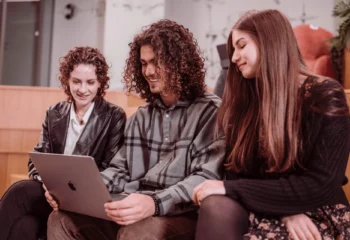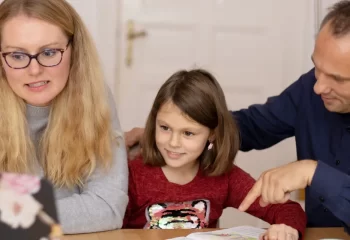This article is part of the Social Interaction in Schools Guide. Learn all about Social Interaction Skills in Education, Student to Student Interaction, and Teacher to Student Interaction.
Overview of Student to Student interaction
Benefits of a student to student interaction
Student-to-student interaction increases in importance each day and now more than ever when the pandemic affected everyone. Students are in their growing years and knowing they can interact with people of an appropriate age helps them create a community of themselves.
Some of the benefits of a student to student interactions are :
– Positive impact on learning
– It helps develop a deeper thinking
Characteristics of classes with low student-student classroom interaction
The classes with lower interactions between the students are more lecture-focused.
The teacher organises the class very well, presents the topic so clearly that there is no need for questions and interruptions and usually covers all questions that may arise.
More than just the teacher’s knowledge of the subject, the teaching style does not give a chance for discussions.
Characteristics of classes with high student-student classroom interaction
The classes with high student interactions are built on that premises.
They either split the class in group discussions or have whole-class conversations.
While the class size matters a lot for these discussions, the teacher’s availability to support these discussions and help students take the correct information out of them is also essential.
Moreover, subjects matter as there are those topics that have more than just one answer. And generating various solutions leads to deeper thinking and increases the capacity for analysing.
Student collaboration activities
Student-to-student interactions, whether formal or informal, can help increase students’ comfort with each other and the online environment. Thus they can be either in-class student-to-student interactions or online.
There are many activities for student collaboration, and some of them are:
– group projects
– group case studies
– peer instruction
– role playing
– synchronous or asynchronous discussions or debates
– collaborative brainstorming
Pair or group discussions
Pair and group discussions can help students develop their communication skills. They work as a group to make presentations, brainstorm and communicate. More than just helping them with their communication skills, it also helps them respect others’ opinions, take turns when talking, listen to what each person says, and give input on the conversation.
Completing shared tasks in a pair or group
Tasks within a group can take more time but can reach better results.
Information exchange activities
Sharing information in a discussion activity is excellent for motivating students to know what happens in other groups. This can contribute to their discussion panels and start a new topic in their group.
Strategies for encouraging Student to Student interaction
There are many reasons student-to-student interactions bring only benefits. For example, the discussions that take place in smaller groups emphasise individual accountability, positive interdependence, and positive interaction in grading the group’s work (P. A. Kirschner et al., (2004), CSCL in Higher Education)
Begin the course with an introduction discussion
An introduction discussion helps students see the general idea of the topic and immediately make connections with what they know and what are their curiosities.
Provide guidelines for respectful, productive, and meaningful interactions
Guidelines help shape the path of the discussions. While guidelines do not tell you what to say, they hint at the topic and help you have a starting point. In any situation, having a clear way toward what you expect brings peace of mind and eases stress.
Student-student interaction in online learning environments
The community of learners does not stop at the in-class studies. It goes beyond this, and the online environment is just as good in student-to-student in-class interaction.
The flexible online classes help students save a lot of time, which counts a lot. Especially since they use this time for extracurricular activities like sports or other passions.
While online learning can help increase student engagement and capacity to focus, it needs more work from the instructors to achieve this. However, the results are worth it. A community of students is no longer characterised by physical proximity but by a sense of belonging and common purpose. (McInnerney & Roberts, 2004)
Begin with an Icebreaker
Icebreakers help students know each other. It can mean
– Introducing oneself
– Sharing photos
– Sharing their passions
Incorporate Group Work
Forming groups and starting to work together allows students to get to know each other. While at first groups may be a challenge, as far as teh work is well structured and the idea behind it is clear, the group work becomes fun.
For group works to run smoothly, one needs to make sure the technology used is known by every participant and is accessible while also running without any problems. “Online discussions quickly become overwhelming in a larger class. I, therefore, created Groups in Carmen and had students discuss in those groups. Online discussions in Carmen allow everyone to participate in thoughtful and meaningful ways, including the students who do not participate in in-class discussions.” Mark Moritz, Associate Professor, Department of Anthropology
Open Multiple Communication Channels
The advantage of using multiple communication channels is that you offer students the flexibility to choose the one that best fits their needs and experiences. It is not biased, and students are advised to use any of them to communicate with their teachers and peers, create groups, and share reviews and opinions.
Include Collaborative Writing and Peer Review
There is nothing more valuable than writing; in education and learning, writing is a big part of shaping someone’s character. Collaborative writing helps students draw on the same subject from different perspectives. They get a glimpse of the other’s strengths and embrace their ideas. Feedback helps us grow, no matter whether it is positive or negative. Peer review is always welcomed.
Conclusion
A balance between the two types of classes should exist – between those that engage students in student-to-student interactions and those that focus more on the course and the lesson without allowing the discussions on the topics.
However, students want and need student interaction in classes. They perceive the interaction degree of a course as a significant characteristic.
Student to Student Interaction FAQ
How do you get students to interact with each other?
When faced with a challenge, students tend to prefer working in a group as there are various perspectives, and they can quickly reach a solution within a group setting. Thus, initialising a challenge that is easier to solve in a group setting is a great way to get students to interact with each other. This can be used for both offline and online environments.
How does student-to-student interaction affect learning?
More than just forming relationships, leadership and interaction skills, student-to-student interaction develops critical thinking, helps students see various perspectives of the same problem, and pushes them to find the best solution and improve their attention skills. All of these, in turn, lead to better academic achievements.
Why is student-to-student interaction important
Student-to-student interaction is the basis of social relationships students have further on. They help students understand the importance of respect in a group, different opinions, group work, leadership and friendships.
How do you increase student interaction in online classes?
Online classes represented a challenge initially as both students and teachers were new to the system. However, as each of them did their best to understand how the online works and to understand the systems that provided them with real-time and live access to sessions, the group works, and social gatherings, the online student interaction became easier.
Increasing student interaction in online classes means having group discussions, sharing social accounts and forming a social media group for informal talks, opening online game channels, having online assemblies on various topics and allowing free open discussions on different course subjects.




